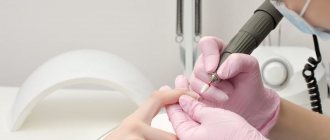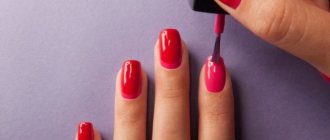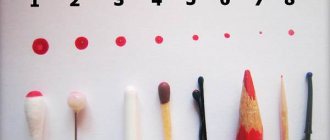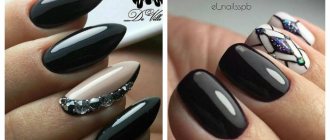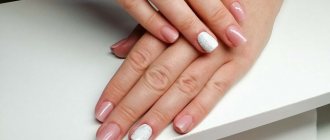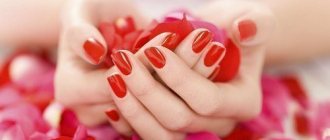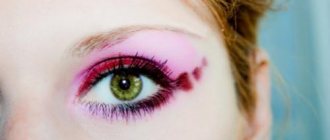There is no need to dry the primer in a lamp; the technology for its use does not provide for this. It should evaporate in air within 30-60 seconds if you place your hand flat on the table, fingers slightly apart. The acid-free one leaves a transparent, slightly sticky and shiny film, while the acidic one leaves a whitish coating.
You can dry the product faster in a lamp by placing your hand there for 20-30 seconds. But this is sometimes necessary when nails are wet. A primer is required when doing extensions; it is also not polymerized during the procedure.
Lamp dirty
Clean instruments are not only the calling card of the master and ensuring sterile conditions. A dirty lamp may cause the polymerization effect to weaken.
Therefore, it is necessary to wipe the lamp daily with the following liquids:
- Liquid for removing the sticky layer with medium dirt;
- Liquid for removing gel polish in case of increased contamination.
Liquid for removing sticky layer
The lamp is not suitable for gel polish type
Most often, the type of drying lamp is indicated by a special marking on the varnish jar (UV for ultraviolet, LED for LED lamp). The latest generation of gel coatings produces varnishes that can polymerize in both types of lamps.
If the method of polymerization of the varnish is not indicated, then when purchasing a product you should ask the seller about this.
Important! In LED lamps, LEDs do not burn out and do not lose their power, therefore, if the selected coating does not require the use of a UV lamp, it is better to give preference to an LED lamp.
Why doesn't gel polish dry in a lamp? Popular reasons
Many girls have a question: why doesn’t gel polish dry in a lamp? One of them had a sticky layer on top after drying. The second girl’s skin on her fingers was tanned, almost to the point of burning. The third client complains that the varnish is peeling off and curling up into pieces. The reason lies in the fact that before you start working with lamps, you need to study some nuances.
Not every lamp is suitable for every varnish. Before drying the varnish, you should read about it, find out which lamp should be used specifically for this type. All work with the coating should be carried out strictly according to the instructions. You may need a certain air temperature or a special liquid to remove the sticky layer.
Why gel polish does not dry in the lamp must be clarified from the very beginning. Ninety percent of failed experiments are due to incorrect purchase and unsuccessful use of special nail dryers. But you can learn how to select the necessary equipment and use them correctly. Let's look at the nuances and subtleties of this issue together, and learn how to choose the necessary drying agent for extended nails.
Content
Why do you need a lamp at all?
Simple varnishes dry perfectly on nails. Just sit quietly for 10 minutes and everything will be ready. Some masters advise placing nails painted with regular varnish under cold water to make drying faster. We tried it, it helps. Modeling varnishes and gel varnishes are created on special high-molecular polymers. These substances are not capable of evaporation, so they do not dry in the usual way. Even blowing a fan on your nails for an hour, or holding them over a warm radiator, will not produce a positive result. Shellac hardens only after its molecular structure changes. This is due to exposure to ultraviolet light.
Types of special devices. UV, LED, CCFL devices are used to harden special varnishes. All dryers operate on the same principle. The result of their illumination is a change in molecules. Polymers are included in decorative products from which artificial nails are formed. The pattern of polymer molecules changes and the artificial nails harden. The main difference between the types of devices is the way the radiation is generated.
UV devices
Dryers of this type have long been known, inexpensive, and are widely popular among craftsmen. These devices are characterized by high power and low cost. They produce extended spectrum ultraviolet light. Therefore, they are able to fix almost any varnishes and gels used to decorate nails. The main disadvantage of these dryers is their short service life. Ultraviolet light devices wear out over certain hours of operation. Also, any click of the switch brings the bulbs closer to burning out. If the device is turned on for a long time, the temperature of the luminous parts rises to 50°C. The metal casing of the device heats up. In this operating mode, you can burn the skin of your hands and fingers. The built-in fan only slightly reduces the temperature.
Therefore, it is not recommended to leave the dryer on for a long time while performing a manicure. The phosphor layer applied from the inside of the walls of the light bulbs becomes thinner, and ultraviolet radiation becomes weaker. Drying with such a defect does not produce a quality effect, and the polymerization of coatings takes too long. Sometimes the gel even pellets, cracks, and becomes a dirty yellowish color.
To avoid such troubles with partial polarization, the active elements in the ultraviolet device should be changed every two or three months, even before they completely burn out. There are devices on sale with induction and electronic switching filters. The induction ignition method protects the dryer from surges in the alternating voltage network and unauthorized power outages.
LED – drying
In LED lamps, ultraviolet rays are produced by special semiconductor parts - LEDs. Semiconductors operate stably, for a long time, without switching off for up to 100 thousand hours, they are environmentally friendly. LEDs do not deteriorate due to frequent switching on and off, their temperature does not increase due to prolonged operation, and the radiation strength does not decrease. Even when one or two LEDs fail, the overall drying efficiency does not decrease. Another positive feature of LED drying is the conversion of most of the energy into light rather than heat. Therefore, varnishes harden much faster and no ventilation is required for cooling. Without a fan, the device is smaller in size, price and weight than, for example, a UV device. A feature of LED dryers is that they produce short-wave light. Therefore, not all coatings harden equally quickly under their influence. Shellacs from recent years are set quickly, in a few seconds. But some take a very long time to harden, especially thick varnishes used to create artificial nails.
CCFL - devices
Cold glow fluorescent tubes decorate any shop windows and city advertisements. They have only recently been used to harden manicures. Inert gases sealed in glass drying tubes emit ultraviolet light. These dryers are much more durable than UV, they can last up to 80 thousand hours. The tubes do not heat up and do not wear out from frequent switching on. These dryers do not require constant replacement of parts. The light emitted by these devices has a wide spectrum of waves, which fixes gels of many modifications. Hybrid dryers with LEDs and fluorescent tubes are often used.
Range of light waves. Artificial nail dryers produce different ranges of light. Therefore, one gel may harden faster, while another may not dry at all. If you are not sure that short wave will set your gel, use a broad spectrum dryer.
Equipment power
LED and fluorescent devices have higher luminous energy. At the same time, they use less electricity. The energy consumed by UV drying to harden the coating on the entire hand is from 36 to 54 W, Inert tubes take 12-18 W, LEDs - from 9 to 12 W.
To use low-power devices, it is necessary to reduce the working area. For one finger, a 9 W UV lamp will handle the fixation. At a time when such a lamp for the fingers of the entire hand may turn out to be rather weak. The varnish will not harden. The speed and quality of fastening will be better from a device that produces light of the required range and greater intensity.
evagirl.ru
The varnish has expired
Do not neglect the expiration date indicated at the bottom of the bottle or on the label. As a rule, the shelf life of varnish is from 1 to 3 years from the moment the bottle is opened.
Important! Often the varnish can simply stagnate or become thick if it is not used for a long time, which also makes it take a long time to dry. In this case, you should first check whether its expiration date has expired, and then “reanimate” it by rolling it in your palms. It is not recommended to shake this varnish.
All gel polishes have a limited shelf life
Types of household tanning lamps and their use
Tanning lamps are sometimes called mini-solariums intended for domestic use; they differ in design features.
Table: designs of home tanning lamps
| Description of design | Specifics | Examples |
| A frame-shaped body, usually 40–80 cm, in which lamps are mounted. Their number differs depending on the specific model: from 1 to 6–7 pieces. |
|
|
| Lamps, ranging from 2 to 7 pieces, mounted on a tripod, usually folding. |
|
|
Depending on the design, the tanning lamp can be used for the face and neck or for the whole body
I have a DR.KERN NT363U for 12 lamps, I’m very pleased with it. I sunbathe for 15-20 minutes every 2-3 days, when I reach the desired shade of tan, I simply maintain it, and so that there is no noticeable difference with other areas of the skin, I go to a regular solarium 2 times a month. (I have naturally dark skin, but in winter my face just turns gray) I buy creams at a tanning studio.
Natick
https://www.woman.ru/beauty/medley2/thread/3847374/
I decided to pamper myself with pleasant treatments during the cold season. I read a lot about home facial solarium Hapro Summer Glow HB 404, reviews from owners, consulted with cosmetologists and finally bought it. On the very first day I decided to try the device on myself. I started the procedure with 3 minutes, then increased the time. After a few days I got a nice tan color. But the effect of the lamp turned out to be not the most favorable for my skin type. On the first day, an allergic reaction appeared. Maybe I overstayed my welcome and should have started from 1 minute. Otherwise I'm happy with the result.
anonymous
https://otzyv.ru/review/654/
Video: Philips mini solarium review
Features of use
Tanning lamps are used in strict accordance with the instructions. It is recommended to start a tanning course with a few minutes, gradually increasing the duration to 5–30 minutes, depending on the specific model.
Contraindications and precautions
Doctors advise against tanning, including tanning using lamps, since in excessive quantities ultraviolet rays can provoke photoaging and, in some cases, the development of cancer. This instruction is advisory in nature, but in some cases sunbathing is prohibited. Thus, the use of ultraviolet lamps is contraindicated for:
- hypertension;
- diabetes mellitus;
- gynecological pathologies;
- high temperature;
- infections, including ARVI;
- chemotherapy treatment (including after the completed course);
- therapy with anti-inflammatory drugs, antibiotics and photosensitizers;
- exacerbations of any disease;
- oncology (including if there are blood relatives with such a diagnosis);
- allergies to ultraviolet radiation;
- dermatological diseases, infectious and inflammatory skin rashes;
- open damage to the epidermis;
- very fair skin and albinism;
- diseases of the cardiovascular system;
- tuberculosis;
- diseases of the thyroid gland;
- psychoneurological pathologies;
- severe liver diseases;
- a large number of moles and freckles;
- menstruation.
Improper storage of varnish
This product is especially sensitive to light, so for proper storage of gel polish you must follow the following rules:
- Always close the bottle of varnish to avoid the harmful effects of both UV lamps and sunlight. Exposure to light may cause changes in the structure of the product. This is why most manufacturers produce varnishes in dark bottles;
- Do a manicure in artificial light to protect the polish from the harmful effects of daylight;
- Store varnishes in dark places;
- Avoid temperature changes. Store the varnish in a place that guarantees a constant temperature of 26 degrees. If the temperature regime is violated, the life of the varnish is significantly reduced.
In addition, gel polish does not like shaking. When shaken, air bubbles form in the bottle, which cause poor surface quality.
Incorrect nail treatment
Often masters violate the procedure for preparing the nail plate for manicure, which leads to the fact that the gel polish does not dry in the lamp.
The procedure for treating the nail is as follows:
- Treat your nails with a buff, which will create a rough surface for applying polish. Treating a nail with a polisher is a big mistake, since a too smooth surface of the nail plate prevents the uniform application of the varnish and, therefore, makes it difficult to polymerize;
- Apply cuticle oil after applying nail polish. Gel polish requires a dry and slightly rough surface. Cuticle oil makes the nail greasy, which creates an extra layer between the polish and the nail.
How to dry primer and when to apply
The primer should simply be air dried. In order for the alcohol components of the liquid to evaporate faster, you need to place your hand on the table, palm down. It is better to keep your fingers open. And you need to try not to tilt your arm to the side. Don't shake your fingers either. If too much liquid is applied, it may spread unevenly on the nails.
The primer is used after a hygienic manicure is performed:
- nails are shaped;
- the overgrown part of the cuticle was removed, the pterygium was cleaned;
- the skin around the nails is sanded;
- The surfaces were treated with a buffer and wiped with a degreaser.
Applying primer is the next step. It is applied to clean nails, that is, there should be no sawdust or skin particles on their surfaces.
Look at the video about what a primer is, how to apply and dry it:
Wrong varnish
Today, the Internet is replete with offers from various brands of gel polishes in different price categories. In this variety, it is easy to make a mistake and buy a poor quality gel polish base that does not dry even if all the rules are strictly followed. Therefore, before choosing gel polish, you should carefully study customer reviews of the product, as well as the reputation of the manufacturer itself.
You should also not skimp on materials and tools for manicure. When choosing them, it is best to rely on the quality of the product. Good quality materials make the master’s work easier, and compliance with the above conditions not only improves polymerization, but also guarantees a longer manicure.

